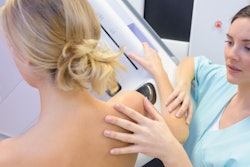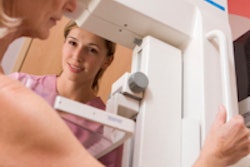
In a move that is already drawing fire from breast screening proponents, the U.S. Preventive Services Task Force (USPSTF) on Monday declined to expand its recommendation on which women should receive regular mammography screening, instead issuing a draft of new breast screening guidelines that largely hew to its more conservative guidance from 2009.
As with the 2009 recommendations, the new guidelines advise that women in their 50s only receive mammography screening every two years, rather than annually as is advocated by many women's health, oncology, and radiology groups. They also stop short of recommending screening for women in their 40s, repeating the task force's belief that the benefits of screening in this age group do not outweigh the purported harms of screening.
Mammography advocates have been quick to criticize the new draft guidelines, using many of the same arguments raised in 2009. But there's also a new wrinkle, as the 2015 guidelines could affect reimbursement for breast screening for women who fall outside the task force's more narrow screening band -- in ways they didn't six years ago.
Same as it ever was
USPSTF generated a firestorm of criticism in 2009 when it rescinded its previous recommendation that women ages 40 and older receive mammography exams every one to two years. In making the change, USPSTF at the time said it based its revision on a meta-analysis of the major randomized controlled trials (RCTs) of screening mammography. The task force said its analysis indicated that in some groups of women the harms of screening, such as false positives and overdiagnosis, didn't outweigh the benefits of mortality reduction.
With the 2015 review, USPSTF said it once again analyzed the evidence from randomized controlled trials, drawing largely the same conclusions:
- For women at average breast cancer risk, most of mammography's benefits will come from biennial screening between the ages of 50 to 74 years, with the highest benefit going to women ages 60 to 69. Therefore, women ages 50 to 74 should undergo biennial screening (a grade B recommendation).
- Screening mammography may reduce mortality for women ages 40 to 49, but the number of deaths that would be averted is much smaller than in older women, and the number of false-positive exams and unnecessary biopsies would be much higher (grade C recommendation). Whether to start screening or not at this age should be an individual decision.
- Screening may be more beneficial for women ages 40 to 49 who have a family history of breast cancer, compared with average-risk women.
- All women who receive regular screening mammography are at risk for overdiagnosis, i.e., the possibility of being treated for issues that would never present a health risk to them during their lifetime.
- There is insufficient evidence to assess the balance of benefits and harms for the use of digital breast tomosynthesis as a screening modality.
- There is insufficient evidence to assess the balance of benefits and harms for screening using modalities such as digital breast tomosynthesis, ultrasound, and MRI for women with dense breast tissue and a negative screening mammogram.
In explaining its analysis, USPSTF noted that breast cancer is the third-leading cause of cancer death in U.S. women, with an estimated 233,000 women diagnosed in 2014 and 40,000 women dying. The median age of death from breast cancer is 68.
The task force noted that it found "adequate evidence" that mammography screening reduces breast cancer mortality in women ages 40 to 74, and the number of breast cancer deaths averted increases with age. But mammography's effectiveness varies with age, USPSTF said, as indicated in the table below.
| Breast cancer deaths avoided per 10,000 women screened | ||||
| Ages 40-49 | Ages 50-59 | Ages 60-69 | Ages 70-74 | |
| Breast cancer deaths avoided | 4 | 8 | 21 | 13 |
And at the same time, the number of harms from screening varies as well, according to the USPSTF analysis.
| Harms of mammography per 1,000 women screened | ||||
| Ages 40-49 | Ages 50-59 | Ages 60-69 | Ages 70-74 | |
| False positives | 1,212 | 932 | 808 | 696 |
| Biopsies per invasive cancers | 100 | 60 | 30 | 30 |
| False negatives | 10 | 11 | 12 | 13 |
In other conclusions, USPSTF did not change its recommendation against clinicians teaching breast self-examination to women, which still has a grade D recommendation. However, women should report lumps and other significant changes to their healthcare provider.
USPSTF acknowledged that the randomized controlled trials on which its analysis was based were performed more than 30 years ago, and that newer, better technology could result in increased detection of tumors. But at the same time, breast cancer treatments have also improved.
"As treatment improves, the advantage of earlier detection decreases, so that some of the women who died of breast cancer in nonscreened groups in these trials would survive today," the group wrote in its document announcing the new draft policy.
'A lot has happened since 2009'
Proponents of mammography have been quick to voice their disappointment that USPSTF chose to stand pat on its screening guidance. One problem is that the task force focused its meta-analysis exclusively on the handful of older, large-scale randomized controlled trials performed on screening mammography, while ignoring more current research.
While the breast screening RCTs are certainly powerful, they were all performed over three decades ago, and they don't provide an accurate estimate of the magnitude of screening mammography's benefit with today's technology, according to Dr. Barbara Monsees, chair of the Commission on Breast Imaging at the American College of Radiology (ACR).
"A lot has happened since 2009; a lot of evidence has emerged that supports a greater benefit to mammography that was not recognized in this new update, and that's disappointing," Monsees said.
The older RCTs associate screening mammography with a mortality reduction of about 12%, which is low compared with current studies, she said.
For example, a 2014 study by Coldman et al published in the Journal of the National Cancer Institute found a 40% reduction in breast cancer mortality in a cohort of 2.8 million women across 12 provincial screening programs in Canada. What's more, the mortality benefit didn't vary much by age.
And a 2011 study by Hellquist et al published in Cancer of mammography exams performed in Sweden on women ages 40 to 49 found a 26% reduction in breast cancer mortality among women invited to screening, along with a 29% reduction for women who attended screening.
"Mammography's opponents say that screening would not be as beneficial today because we have better treatment, but these studies compared contemporaneous women," Monsees said. "So regardless of whether to screen or not, they were all treated with same treatment at the same time. They show that the mortality difference is not due to treatment: The difference is due to screening."
Economic impact?
When USPSTF changed its guidelines in 2009, it fueled an ongoing controversy that continues to this day, but there wasn't a major effect on reimbursement for screening mammograms, such as for younger women. That's because U.S. Secretary of Health and Human Services Kathleen Sebelius immediately ruled that Medicare would use the task force's older 2002 guidelines to determine payment. Private payors largely followed suit.
But things are different now, mainly due to the implementation of the Affordable Care Act (ACA). The ACA states that private payors are no longer required to reimburse beneficiaries for services that have not received at least a grade B recommendation from USPSTF.
That means that some private insurance plans may no longer pay for mammograms of average-risk women in their 40s. Likewise, older women in their 50s and early 60s may find it more difficult to get reimbursed for annual mammograms because only biennial screens received a grade B recommendation.
Ironically, Medicare is not affected by the ACA rules, as the federal program is governed under a separate statutory mandate, according to ACR.
"One of our greatest concerns is that women will not come for screening if they can't afford it," Monsees said. "This will impact low-income women who can't afford a co-payment."
Despite the setback with the new guidelines, Monsees noted that what was released this week is a draft, and there is a 30-day comment period in which interested parties can comment. She admitted, however, that she's not optimistic that the task force will change its position significantly.
More information about the 2015 draft guidelines is available by clicking here.



















